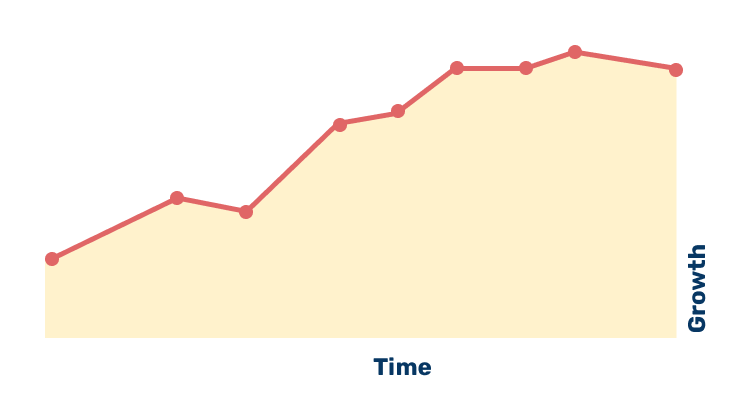
How to get out of a growth slump
Imagine this; you’ve been working at a company for a few months; at first, it was terrific. You were in the honeymoon period, and there was so much **** (aka growth). During this time, flaws (losing experiments) were easy to ignore; life was bliss. In your happiness, you set more stringent targets to hit; you feel invincible.
But then, as the months go by and the shine wears off, you realize you’ve missed your target for a week. This dip in results has to be a blip… you prefer to be optimistically daydreaming of those sweet honeymoon memories.
One week becomes two weeks, and two becomes three weeks. Okay, that is too long; you try to bring the **** back with an extra ad, a new campaign, and you adjust the landing page. Maybe it is time to test a new channel? You and your growth team need to talk and figure out what’s going on. You procrastinate planning this meeting in, don’t you? What if bringing it up makes it worse?
Suddenly, three weeks becomes four weeks; four quickly becomes five, six and then seven. You are freaking out, and then the phone rings. Spoiler: it’s your manager with “We need to talk about the results.”
It happens; growth stalls at times. It could be because of internal factors:
- A channel is milked to its max
- You haven’t got the language right for a broader audience
- You don’t have enough products or variations, etc.
Or an external factor:
- You have a new competitor
- Market desires are changing
- Seasonality
- Advertising platforms are getting more expensive, etc.
It doesn’t matter what the cause is; you’re smart enough to look into that and figure it out. What matters is that you stop. Yes, stop. But, what usually happens when results start to lag is the situation we described above. We become an optimist hoping it’s just a blip. The alternative is that we race around like a headless chicken… running lots of haphazard experiments, trying to test more and more. Neither reaction works.
There are a few reasons growth stalls beyond the common internal and external factors already mentioned:
Sometimes time tells that one of these is at play. Fay, a fellow growth consultant, and I talked about this in a podcast episode for GrowthMentor:
“In the beginning, with the first batch of customers and reviews, all is going well. You definitely have Product/Market Fit (PMF)! Yet, you start hitting the ceiling and realize you’re struggling to convert people and scale up further. This is why it is important to keep talking with customers and non-customers.” — Fay Lodder, Spotting Growth.
Scrambling to improve the situation and trying to get more done won’t solve the problem. When you get stuck, the worst thing to do is more of the same again. Doing more of the same will not solve the situation; it will only get you more stuck.
When you get stuck, it can also get nasty: people can turn on each other, pointing fingers. Growth goes from being a team sport to a “who did it?”. The result is defensiveness and fear, neither gets you unstuck nor brings the **** (aka growth) back.
Don’t worry, there is an alternative, but it is the opposite of what feels natural to most. So take a deep breath and take a quiet step back. The optimizations you were trying to do were just band-aids and won’t solve the root cause of it all.
As mentioned before, turning things around is all about figuring out what happened in the first place. Maybe, you have already analyzed internal and external factors but can’t find anything crazy. Often this is a case of hitting a growth ceiling; it might just be that you’ve gotten everything you can out of the current setup; I’ve seen this happen on several occasions.
Go back to your North Star Metric. From there, do a full-funnel analysis again to look at the whole setup. Look not just at the funnel but at other elements that may be holding you back. Remember that growth is a combination of different areas:
- Product
- Marketing
- Brand
- Data
- Company culture
- Strategy
Often when growth stalls we focus and blame marketing rather than looking holistically at growth. When actually whether or not you can scale your product is the result of getting multiple matches right between the Market, Product, Channel and Model.
Too often, slow-growth companies blame marketing channels and think they need another channel to solve it. However, channels are only one piece of the puzzle; there are multiple matches to get right:
- Product/Market Fit: Are you offering a product your market actually wants?
- Product/Channel Fit: Are the channels suitable for marketing your product?
- Product/Model Fit: Does the business model work for the product you are offering?
- Market/Model Fit: Have you got the right business model and pricing for your market?
- Channel/Market Fit: What are the right channels to match your market?
- Channel/Model Fit: Do the channels work in terms of cost of acquisition for your business model?
This is not to overwhelm you with questions but to challenge your business to come together and look at growth holistically. To not see a lack of growth as a marketing problem (that is one of the main reasons I strongly claim Growth isn’t Marketing).
Hackajob, a job platform for developers, is the perfect case study of how looking holistically at your product/market/channels/model fit can help turn your growth around. They had an 18-month period of little to no growth:
“We got out of our growth slump and scaled up hugely, but it resulted from three major changes. Firstly, we doubled down on our persona: what type of companies we did and didn’t want on our platform. Secondly, we changed our business model to suit better their needs of hiring top talent cheaper and easier. Finally, we embraced having a separate brand budget without conversion goals. We got an incredible new team member onboard on the brand side and she built out the awareness layer of our business.” — Mark, CEO Hackajob
If possible, get someone else in to take a look with you; it’s easy to be blinded by working for one company for too long — you suddenly can’t see the wood for the trees. The best ideas come from such discussions and looking together at new approaches and perspectives.
From there, develop potential hypotheses so what could be stalling growth. Then, can you research and understand them further?
Let’s say you realize the significant issue seems to be retention, that in getting caught up with the top-line growth, you missed how retention was slowly creeping up. This meant that you needed to bring in more and more new customers to keep that top-line growth. So take the time to break down the different retention cohorts and where the issue is. You find that the drop-off is early on the product life cycle, meaning it is more an activation issue.
Often the problems that arise are the result of not doing enough initial research to truly understand your customer and figure out these matches. Then when you try to scale, that rocky foundation holds you back. More often than not it requires going back to the basics, customer research as Fay mentioned in our podcast episode:
“So many things can go wrong when you don’t spend enough time in the beginning when you’re building your foundation. For instance, one of my clients tried to sell their products with the wrong pricing model, leading them to need so much traffic and investment to get a visitor to convert to a customer that it wasn’t profitable.
We implemented exit-intent pop-ups and scheduled interviews with both customers and non-customers to gain more insight into how the current pricing was impacting our growth.” — Fay Lodder, Spotting Growth.
Dare to think big, but test small. Get out of your comfort zone.
Growth comes from daring to do things drastically differently rather than hitting your head against the same wall.
It is hard when growth stalls; it can feel like a personal failure. But, it isn’t; growth is a team effort. It requires rallying your company together to have honest conversations and take a proper step back. To set aside egos and try to understand where it is going wrong. Only then will it be possible to get growth back.
This article is based on one of the chapters of my book, Growing Happy Clients and was developed further with Fay Lodder, Spotting Growth, to ensure it was even more actionable and reflective of what it takes to get your growth back on track.



